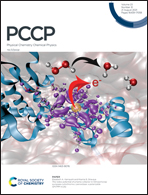Mechanical properties and thermal conductivity of newly introduced graphene-like borophanes: a reactive molecular dynamics study
Abstract
A newly proposed borophane structure is characterised mechanically and thermally in this work by using a reactive molecular dynamics study. A full hexagonal lattice of borophene is connected with other hexagonal lattices by placing hydrogen atoms as the connecting bridges. It is found that hydrogenation improves the Young's modulus of armchair borophene significantly. However, this noticeable increase is not found in the case of thermal conductivity. There are only slight variations of thermal conductivity upon hydrogenation. The increase of temperature was then found to decrease the Young's modulus and thermal conductivity. The presence of a vacancy defect also diminishes the Young's modulus of borophene remarkably, yet this reduction is less significant when borophene is hydrogenated which shows the stabilising effect of hydrogenation on the mechanical properties of borophene. The removal of a single boron atom was also found to provide an insignificant reduction in thermal conductivity. Given the mechanical and thermal stabilities of the proposed borophane structure, this structure can also be used as an alternative to the recently synthesised H1B1 hydrogen boride sheet. It is expected that this work will provide meaningful insights for the design of on-board hydrogen storage applications.



 Please wait while we load your content...
Please wait while we load your content...